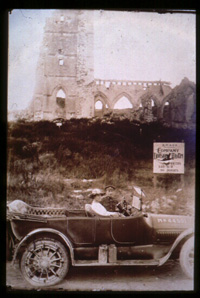
in front of a bombed-out church,
France, ca. 1919-1922
This post was updated on March 9th 2019 with the addition of a postscript: A film about Hamilton’s life and work via ht @LucyLondon7
This is one of those “nevertheless she persisted” stories.
The Canadian artist Mary Riter Hamilton had studied in Europe before having to return to Canada to care for her ailing mother. At the outbreak of the war in 1914 she was living in Victoria, BC and it was not long before she was campaigning to be allowed to go to France and Belgium to paint the Western Front. Her requests were repeatedly denied.
Two Canadian women artists applied to go to the battlefield E. Dorothy McAvity and Mary Riter Hamilton. Both were rejected.
Hamilton pursued her ambition vigorously in the face of official opposition, writing in support of her case to the Prime Minister and anyone she could find. She was agitating to travel overseas and record frontline action as early as January 1917 when she applied to the Canadian War Memorial Fund (CWMF) Lord Beaverbrook. This was more than a year before the first group of official Canadian artists left for the battlefields.
The terms of the fund specified that only male artists would be allowed to go out to the battlefields. A few women – Henrietta Mabel May, Dorothy Stevens, Frances Loring, and Florence Wyle, for example – did receive commissions, but their work was confined to the home front.
Undaunted by the regulations, Hamilton persisted and through a military friend contacted Prime Minister Borden arguing that she “needed the employment that the creation of war records could give her.”
She received no reply and in April she appealed directly to the fund. Her appeal revealed her understanding of the war and the scope and importance of the work. In May 1917 her request was denied without explanation.
Hamilton did not apply again but nevertheless she found her way to France and Flanders.
Throughout the war Hamilton had done relief work for the Red Cross and the Belgian consulate. She was well aware of the impact of the war. She was a friend of J.A. Paton, editor of the Gold Stripe, a magazine of the Amputation Club of British Columbia, and she knew that returning soldiers faced physical and psychological trauma, Finally, in 1919 she was commissioned to go on behalf of Club to paint the battlefields of France and Belgium for publication in the The Gold Stripe.
Her story reveals the gender and cultural bias that characterized the official Canadian War Memorial Fund program. Her efforts to become an official war artist for Canada were stonewalled, ignored, blocked and denied. She was excluded entirely from the official Canadian war art effort.
Her project was to create a war map by painting the scenes where Canadian soldiers had fought. Her work was not officially sponsored by the government and what Hamilton created was a deeply personal documentation of direct experience.
“I came out because I felt I must come, and if I did not come at once it would be too late, because the battlefields would be obliterated, and places watered with the best blood of Canada might be only names and memories. Of course the great facts of the war would remain, and I could add nothing but my pictures to the essential tragedy and meaning of it all, but it seemed to me that something was in danger of being lost.
I do not think I could re-live that time; and I know that anything of worth or anything of beauty which may be found in the pictures themselves reflects only dimly the visions which came then; the visions which came from the spirit of the men themselves.”
Letter from Mary Riter Hamilton to Dr. Arthur Doughty, Dominion Archivist, 27 July 1926
Life was not easy in those battlefield areas after the war. It was often lawless, desolate and dangerous with unexploded ordnance everywhere. At first she was attached to Canadian and British War Graves units who were busy exhuming and burying the dead. She stayed with the remainder of the Canadian Corps that served in France until 1919, then with the Red Cross and the Chinese laborers hired by the British and French government to clean up the battlefields.
The Chinese Labor Corps – required to remain after the armistice – were doing the dangerous work of locating mines and unexploded bombs, filling in trenches, removing barbed wire and reconstruction. They also located the bodies of the missing and dug up the shallow makeshift graves and recovered the dead for reburial. The battlefields were littered with deadly debris and hundreds of these laborers died.
Hamilton endured the hardship of makeshift accommodation, poor food and hostile weather. Unlike many other war artists, she did not reconstruct scenes or paint from photographs; rather, she depicted the aftermath of war as she herself witnessed it. It was an experience that drained her physically and emotionally.
“I made up my mind that where our men went under so much more dreadful conditions I could go, and I am very proud to have been able even in a small way to commemorate the deeds of my country men, and especially if possible to lend a helping hand to the poor fellows like those of the Amputation Club who will be life-long sufferers from the war.”
[Mary Riter Hamilton, in an interview with Frederick G. Falla, The McClure Newspaper Syndicate for release September 10, 1922]
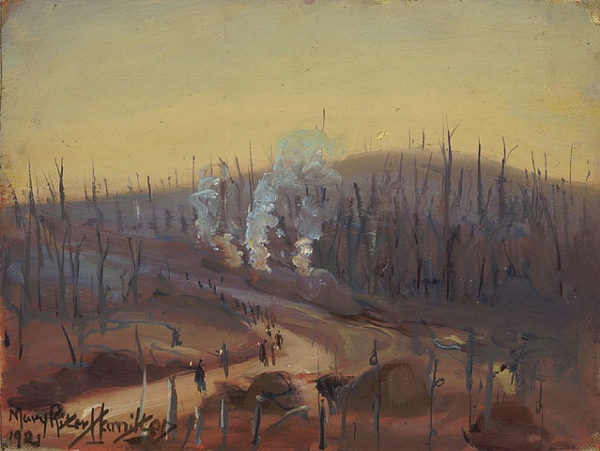
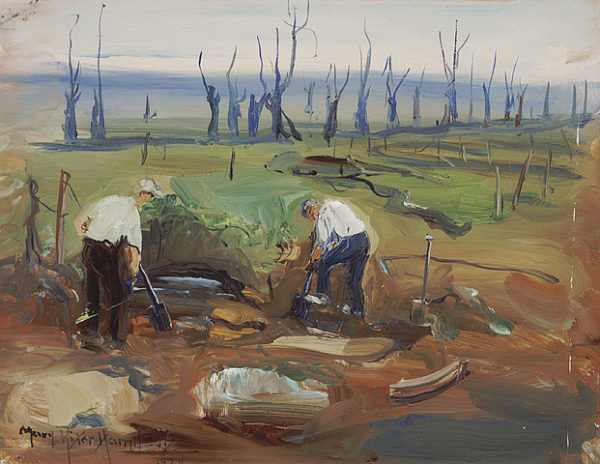
Returning refugees found their homes, farms, villages and downs devastated and broken. They struggled to resume normal lives amid the ruins.
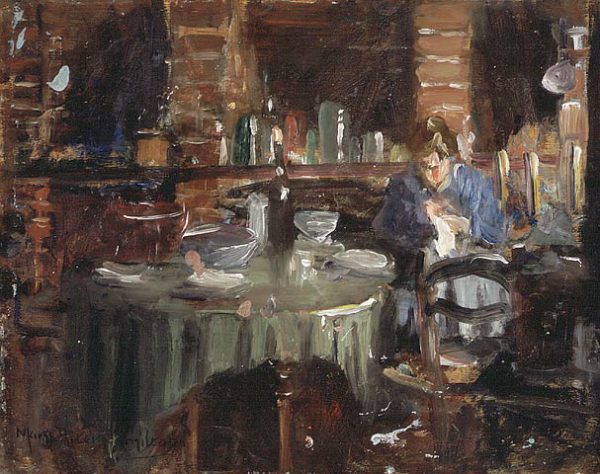
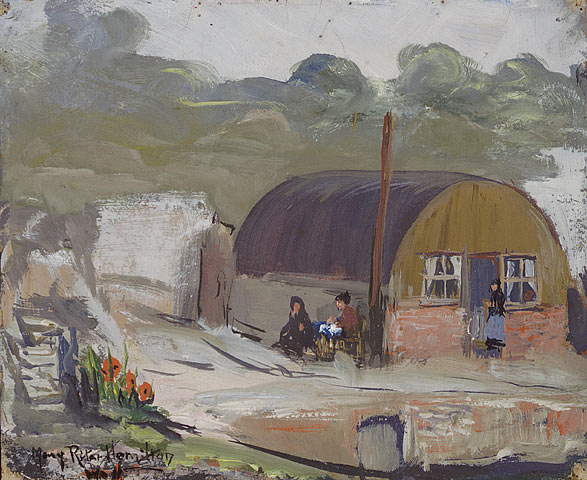
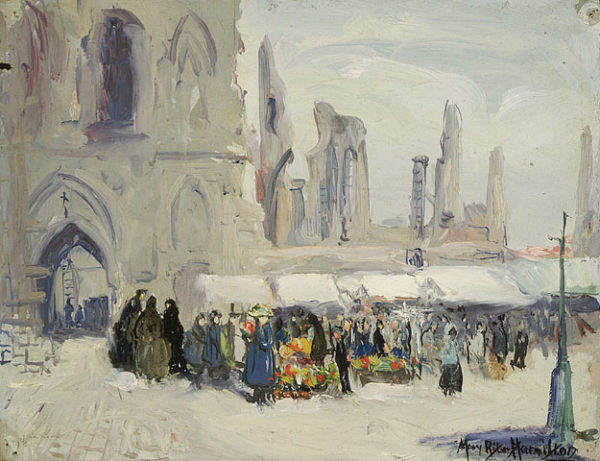
Life did return.
“I feel that it is fortunate that I arrived before it is too late to get a real impression. The changes are taking place rapidly and even in the short time I have been here I can see a great change. In another few months there will be very little trace of war… There is nothing in any way amusing about seeing this devastated country; indeed it is one tragedy after another.”
[Mary Riter Hamilton, letter to The Gold Stripe, May 1919]
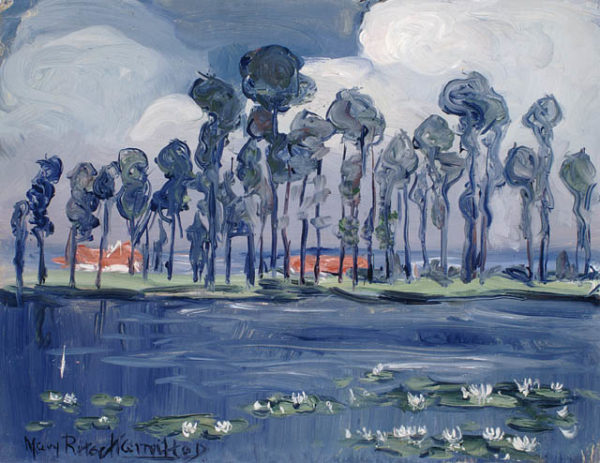
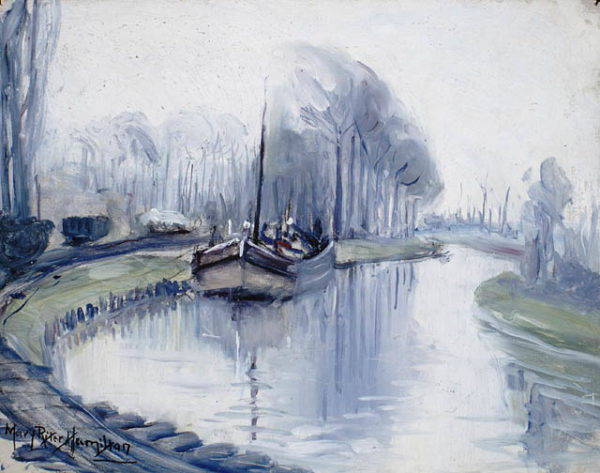
And as the journey toward recovery begins there are bodies to be found and graves to be dug and memorials to be built. The journey of grief and loss is long, lonely and melancholy.
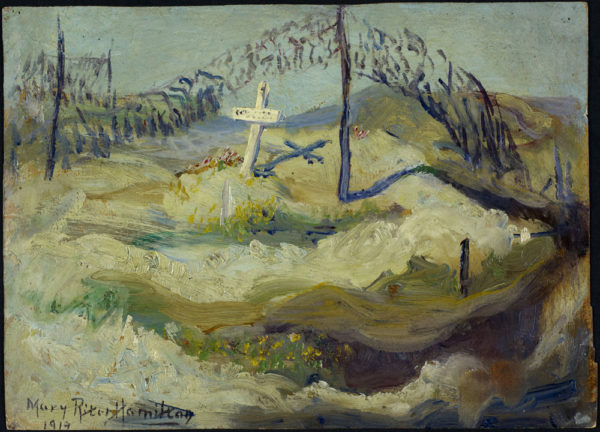
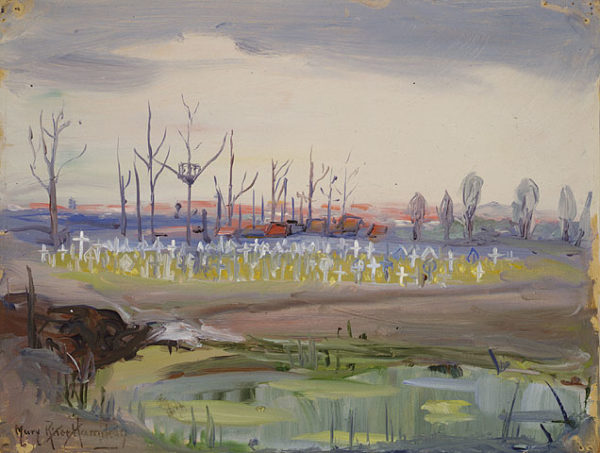
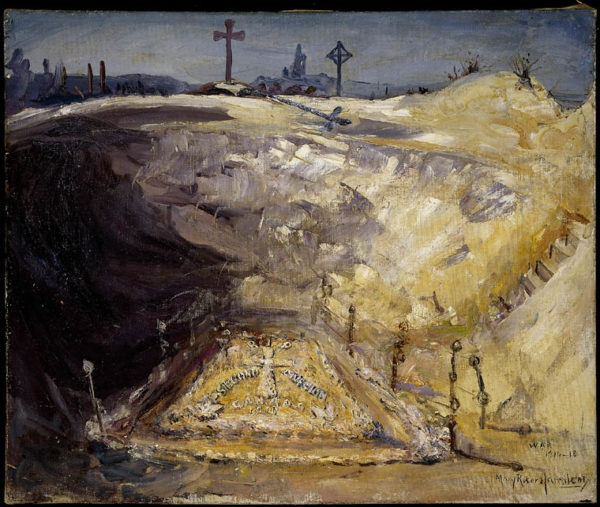
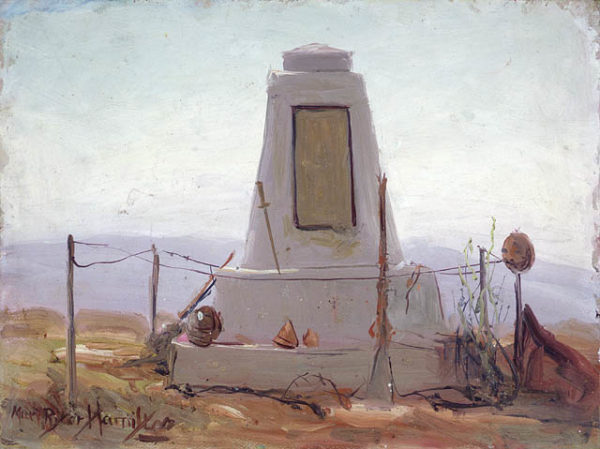
It is not surprising that Hamilton painted many pictures of St. Julien, Vimy and the Somme.
“I go to Europe in order to paint the scenes where so many of our gallant Canadians have fought and died, because this can be only done successfully before the reconstruction of France and Belgium has really started… there is no doubt about the magnificent ability of our fighting men and I fairly ache to get to the scene of their heroic exploits.”
[Mary Riter Hamilton, interview with Anne Anderson Perry, Western Women’s Weekly, February 1, 1919]
It was at St Julien in Second Battle of Ypres that the Canadian First Division – and the Algerian troops to their left – were exposed to the first poison gas attack, 22 April 1915. That use of poison gas was shocking and condemned. The Allies had their own supplies of poison gas – euphemistically called “the accessory” – and they soon used them.
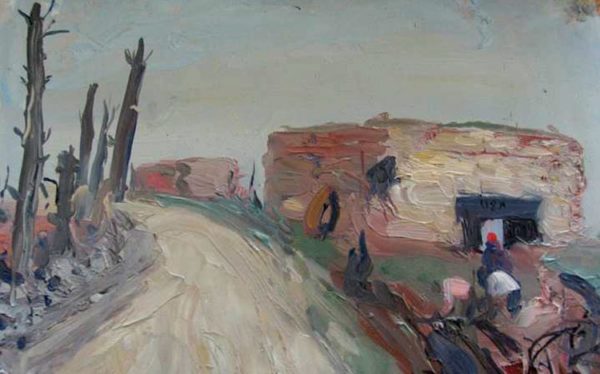
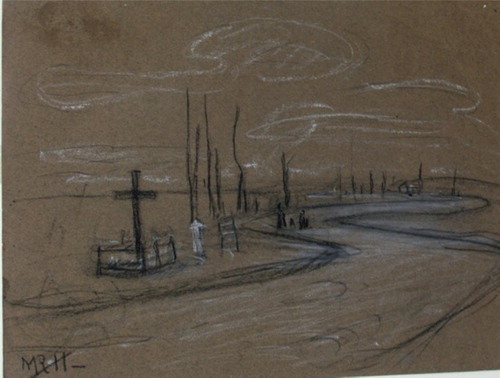
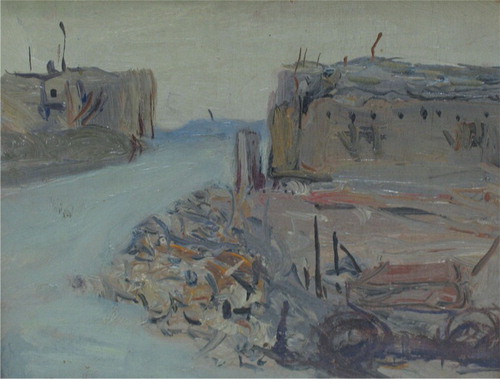
St Julien, 1920. A close up of crumbling bunkers in a street that was once a military thoroughfare. The pillboxes are examples of the military infrastructure that endures in the landscape – fortified concrete, steel-enforced structures made to withstand shelling and machine gun fire – a precarious shelter in time of war. The rubble in the foreground suggests St Julien has not yet cleared up the scars of war. There are no people in Hamilton’s St Julien – just the broken buildings standing in for casualties and the emptiness as a reminder of the missing – the living, wounded and dead, to whom her artistic work is dedicated.
Two years later – in April 1917 – was Vimy Ridge.
Four Canadian divisions stormed and overran the Germans all along a heavily fortified front. They continued to move forward even under heavy fire that killed their officers and saw hundreds cut down. In countless individual acts of extreme courage they charged machine-gun nests and forced the surrender of Germans in protective dugouts.
Hill 145 was the highest and most important feature of the Ridge. It was captured in a frontal bayonet charge against machine-gun positions. It’s where the Vimy monument now stands.
Vimy Ridge stands as a defining moment for Canada – an example of sacrifice, courage, discipline and a source of national military pride. The battle lasted three days but the success was costly: 3,598 Canadians were killed and another 7,000 wounded. The Germans suffered an unknown number of casualties with approximately 4,000 taken prisoner.
“It is fortunate that I arrived before it was too late to get a real impression. The first day I went over Vimy [Ridge], snow and sleet were falling, and I was able to realize what the soldiers had suffered. If as you and others tell me, there is something of the suffering and heroism of the war in my pictures it is because at that moment the spirit of those who fought and died seemed to linger in the air. Every splintered tree and scarred clod spoke of their sacrifice. Since then, nature has been busy covering up the wounds, and in a few years the last sign of war will have disappeared. To have been able to preserve some memory of what this consecrated corner of the world looked like after the storm is a great privilege and all the reward an artist could hope for.”
[Mary Riter Hamilton, in an interview with Frederick G. Falla, The McClure Newspaper Syndicate for release September 10, 1922]
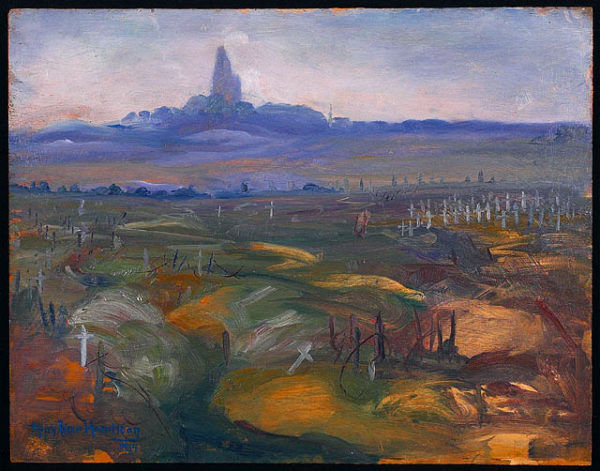
Here’s an interesting contrast. three artists with the same picture of the Lens – Arras road about halfway along – going north towards Lens – and looking down onto the village of Vimy from Vimy Ridge.This was part of the four-mile, heavily fortified strategic height – occupied by the Germans since October 1914 – that the Canadian infantry recaptured in April 1917.
Below on the left is by the Canadian artist David Milne – a bleak scene with lone cyclist on the road. The painting on the right is by Herbert Hughes-Stanton (c.1918) and shows the roadside with canvas baffles stretched between poles to hide troop movements from the Germans. A French howitzer battery – with the gun dismantled into three sections for transportation – is moving north.
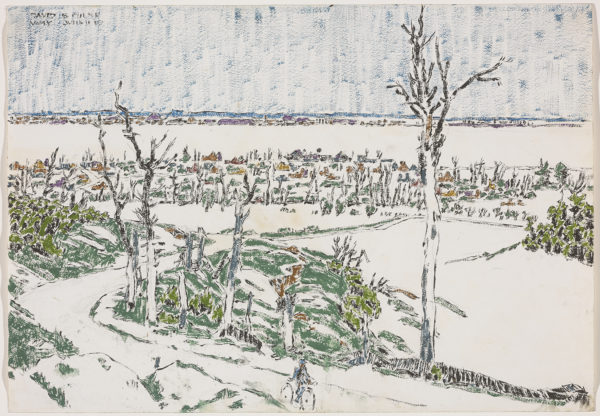
above Vimy Village. David Milne 1919
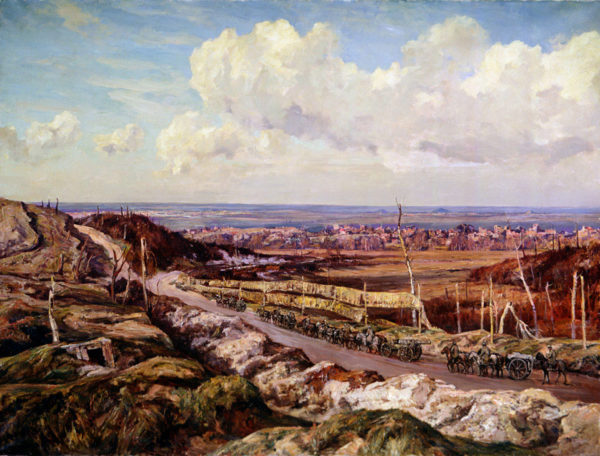
Lens and Henin Liotard in the distance.
Herbert Hughes-Stanton.1918
Hamilton’s painting is closer and more intimate, a different season. The troop movements are gone and the scene is like a country road with bare trees and severed stumps.
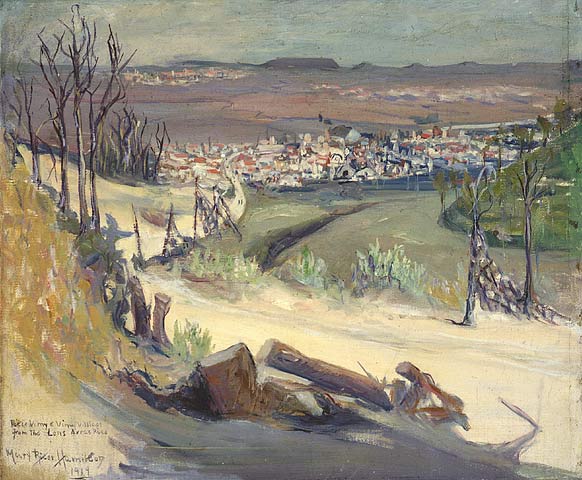
And so to the Somme.
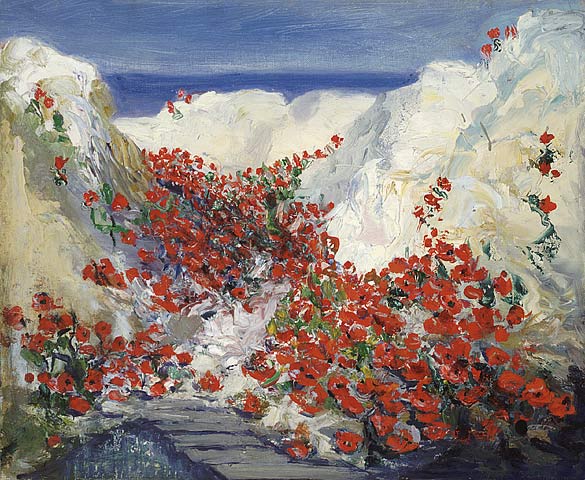
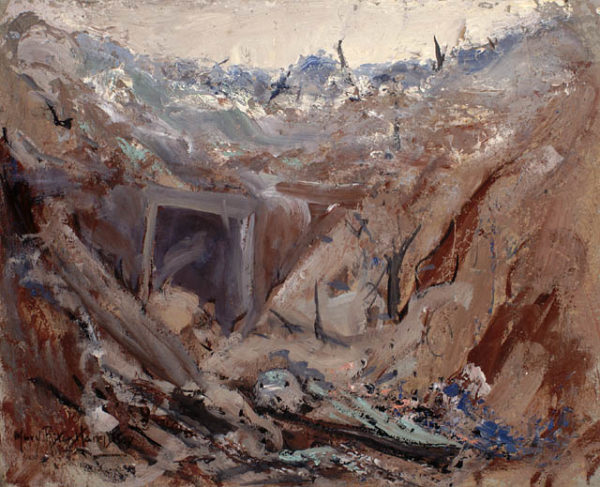
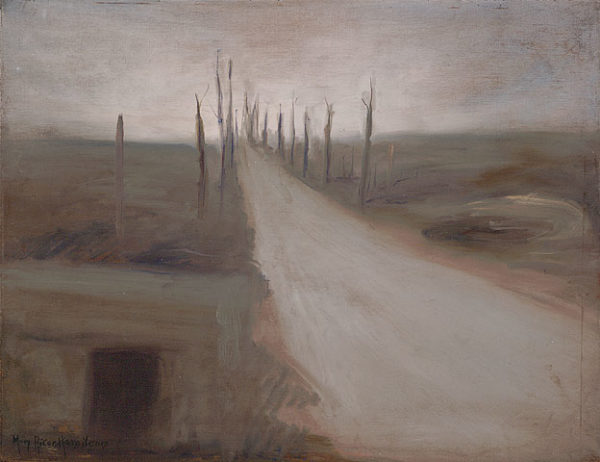
Hamilton’s work shows a landscape and people recovering from war. She painted the shell craters, abandoned posts, and dug-outs, memorials and roadside graves of a land laid waste by war. Some of the paintings have a haunting and spectral quality. Others burst with color and the beauty of the light and the sky in spite of the resonance of death and details of damage and destruction.
Her paintings document the return of everyday life, the re-growth of grass and trees, and the softening and greening of the torn lines left by the millions of shells that churned the landscape. Many of her landscapes are unpeopled, melancholy scenes of desertion and desolation – desolate streets, smashed churches, empty cratered roads and crumbling pill-boxes. Others show the return of the people to the towns and villages and the rebirth of daily life.
Her paintings are small understated tributes to the land and those who fought there. They are a fine contrast with the propaganda of monumental patriotic paintings that were commissioned to celebrate victory. They are instead a powerful tribute to what had been and to the soldiers who fought and died and lost their limbs in a far off place.
The landscapes stripped of inhabitants are populated instead by crosses and the rusting, crumbling, rotting debris of war. Her paintings are a visual narrative of forgotten perspectives and stories of the war. She did not reconstruct scenes or paint from photographs; rather, she depicted the aftermath of war as she herself witnessed it. She painted the sites of memory. She captured the destruction and recorded the process of renewal.
Hamilton stayed in Europe for three years and produced over 300 paintings on canvas, paper and cardboard.
She worked with oil, charcoal, chalk and water colors. Her work was exhibited in London and by The Amputation Club of British Columbia. Some of her work was sold to raise money for veterans but Hamilton donated most of them – 227 in all – to the National Archives (now part of Library and Archives Canada) in 1926.
She died in relative obscurity in 1954 in Vancouver at the age of 81 and was buried beside her husband William in Port Arthur, Ontario.
In these years of Great War centennials, Hamilton’s work speaks across time with a freshness and perspective that is hers alone. Her unofficial status meant she had none of the privileges of the official war artists – military rank, a uniform, and an income. Her paintings often reveal a hidden beauty in the wasteland. They are neither militaristic propaganda nor sentimental. They are something else. Hamilton created her own space to document what she saw. She intended her work as a tribute to Canadian soldiers and her work is a heartfelt, generous and wide-ranging recognition of their courage, suffering and sacrifice. What she had was a freedom to document what she saw Hers are not grand and monumental public works. They are small, often rather intimate and personal paintings from her experience and sensibility. There’s nothing jingoistic about them. She painted the crosses of German graves on Passchendaele Ridge as respectfully as those of Canadians. Hamiliton had studied in Berlin and her vision and visual narrative are larger than the “quarrel with the foe”.
There is nothing of John McCrae’s vengeful defiance.
We are lucky to have her work as a permanent record.
Thank you Mary Riter Hamilton.
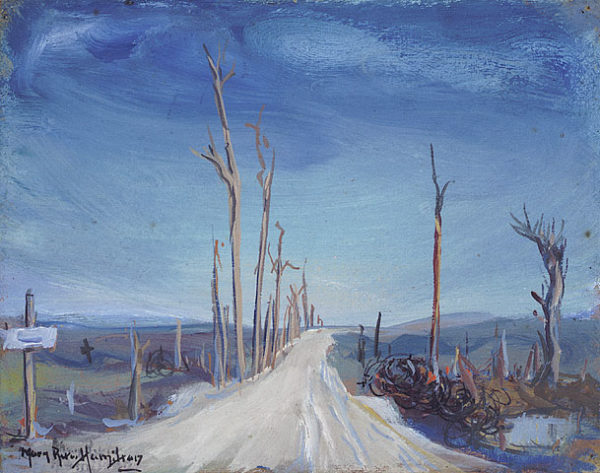
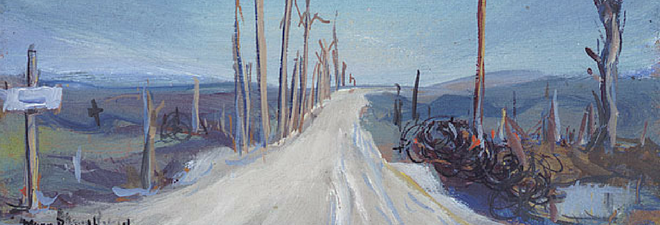

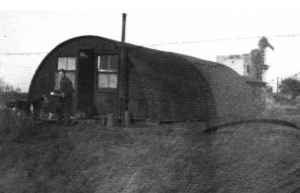

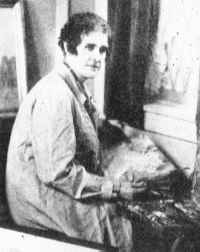


Another wonderful blog. So many artists I haven’t seen before. Thanks for sharing.
Gwen.
Wow! Great read and great paintings. Thanks for sharing! Glad I stopped by.
Haunting and beautiful. Makes me want to take a trip to Canada to see them.